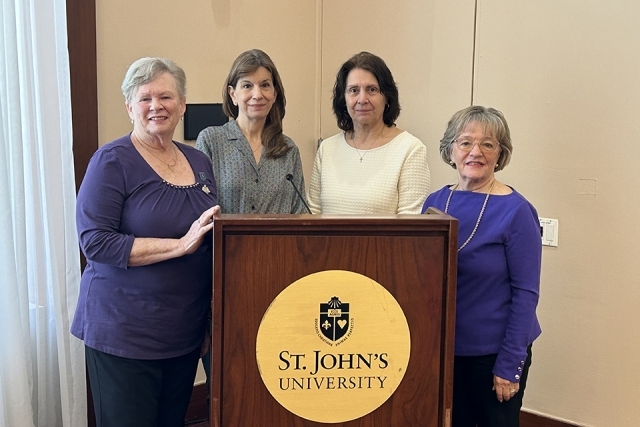
Wife, mother, grandmother, widow, religious organizer, servant of the poor: St. Louise de Marillac embraced many roles during her life, and that is why she is an essential ambassador of the Vincentian heritage of St. John’s University.
The life and legacy of St. Louise was the subject of a Lenten reflection held on March 14 by four members of the St. John’s chapter of the Ladies of Charity, a Catholic organization of lay women dedicated to working against poverty in the spirit of St. Louise and her collaborator, St. Vincent de Paul.
Born in France in 1591, St. Louise married in 1613 and gave birth to a son soon thereafter, only to be widowed in 1625. In 1629, she began a partnership with St. Vincent that would lead to establishing the Daughters of Charity religious order in 1633.
St. Louise was canonized in 1934 and is the patron saint of social workers.
“There have been many collaborators in the history of the Church,” said Maryann Dantuono, J.D. ’81L, a member of the Ladies of Charity and former Associate Director of the Vincentian Center for Church and Society at St. John’s. “But I think the collaboration between Sts. Louise and Vincent is a great model for our world today. Neither one wanted to accomplish things without the other.”
Ms. Dantuono is a nongovernmental organization representative to the United Nations for the International Association of Charities, a federation of groups organized to alleviate poverty in the spirit of Sts. Louise and Vincent. She joined three fellow Ladies of Charity—Belenna Lauto ’81C, Professor, Department of Art and Design, St. John’s College of Liberal Arts and Sciences; Margaret Cashin ’96A, ’03C, who retired in 2018 after a 28-year career with the University’s Office of Community Relations; and Anna Rocchio, a retired New York City teacher and former Copresident of the St. John’s chapter of the Ladies of Charity—in introducing a gathering of St. John’s administrators and staff to the work done by the Ladies of Charity.
The lecture was held before the St. John’s chapter’s annual Evening of Hope on April 12 at Terrace on the Park in Flushing, NY. The fundraiser supports those on the margins of society, emphasizing the educational needs of women and children. The Ladies of Charity will present their annual Spes Unica (Only Hope)award to author Alice McDermott, whose novels recognize the dignity of all people.
The Ladies of Charity model their work after St. Louise, who helped to organize hospitals, schools, and orphanages across France. At her death, more than 40 Daughters of Charity convents had been established in Europe.
“She was persistent,” Ms. Cashin said. “She might suggest something to St. Vincent, who would say, ‘No, we should do it this way.’” But she would persist and eventually get him to see things differently, say, in how women should be treated.”
St. Vincent was initially wary of a partnership with St. Louise, whose energetic personality clashed with Vincent’s more deliberate approach. However, over their 35-year partnership, they were able to work together to serve France’s underprivileged.
With St. Vincent’s blessing, the Daughters of Charity began teaching the poor children of France. Gradually, they became involved in other charitable works, earning the title “Angels of the Battlefield” for their work among the wounded and sick in Europe’s conflicts and later during the American Civil War.
The panelists said that partnership model should inspire us to a greater awareness of what purpose-driven individuals can accomplish together.
“If there is a model we need in our church today, it’s collaboration,” Ms. Rocchio said. “It is not, I will be the one and only hero, but rather, how can we work together to make things happen? How can we see each other as colleagues and friends, and people who want the same goals in life?”
“It’s hard not to love her courage and the fact that she felt excited about something that had to get done,” added Professor Lauto. “It was never, we cannot get this done. It was about how are we going to get this done?”
Among Catholic religious leaders, St. Louise is rare in having enjoyed life as a wife, mother, and grandmother before entering religious life. That diversity of experience helped her ministry flourish, according to Alexia Dolamakian ’19TCB, Assistant Director of Social Justice, Vincentian Institute for Social Action, who attended the lecture.
“What makes St. Louise’s life so special is that she was ordinary,” Ms. Dolamakian said. “She had many roles—a mother, wife, grandmother, and organizer—but still found time to work tirelessly on behalf of the poor. Reflecting on her selfless love prompts the question, what more can I do despite my ordinary and often busy life?”
